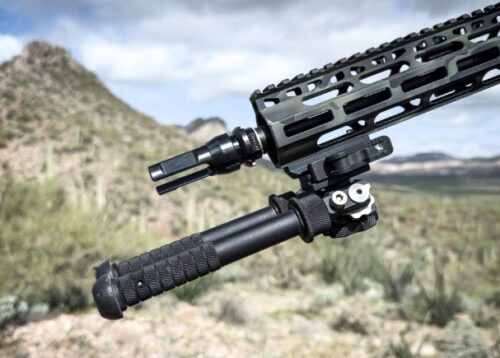When it comes to long-range shooting, every detail matters—and stability is the foundation of precision. The best bipod for long range can make all the difference, whether you’re dialing in on a target from hundreds of yards away or tracking game in the field.
The right bipod doesn’t just support your rifle; it boosts your confidence, enhances accuracy, and keeps you steady in any terrain. But with so many options on the market, how do you choose the one that fits your needs? Let’s break down what to look for in the best bipods for long-range shooting and help you find the perfect match to elevate your shooting game. But first;
Why Do You Need a Bipod?
A bipod is a must-have for long-range shooting because it gives you the stability you need to stay accurate over longer distances. Holding a rifle steady, especially for extended periods, can be challenging, and even the smallest movements can throw off your shot. A bipod takes that strain off your body, keeping your rifle rock-solid and freeing you up to focus on your target and trigger control. Whether you’re shooting in the field or at the range, it helps you stay consistent, adapt to uneven terrain, and make precise shots when it matters most.
Best Bipods for Long Range
Without further ado, let’s dive into the best bipod for long range recommendations:
1) Caldwell XLA Bipods 445088
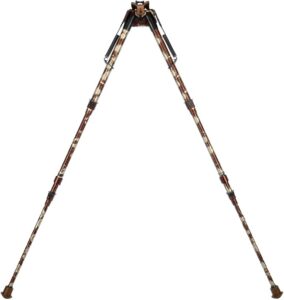
The Caldwell XLA Camouflage Hunting Bipod 445088 is the best bipod for long range. It is made with precision and attention to detail and is designed to enhance shooting accuracy while maintaining portability and ease of use. Its lightweight aluminum construction, combined with an array of thoughtful features, makes it a standout choice for hunters and precision shooters alike.
One of the defining features of the bipod is its compatibility with virtually any firearm equipped with a sling swivel stud, ensuring broad usability. The lightweight aluminum design keeps the bipod unobtrusive, minimizing additional weight on your firearm.
The spring-loaded legs deploy instantly with the push of a button, offering rapid setup for unexpected shooting opportunities. These legs are also notched for height adjustments, allowing users to customize the bipod to their specific needs and terrain, providing the perfect angle for a steady shot.
Another standout feature is the connection point for sling attachment, which seamlessly integrates the bipod into your firearm setup without sacrificing sling functionality. The multi-section legs collapse forward, making the bipod compact for carrying while on the move.
Stability is a top priority, and the soft rubber feet ensure a firm grip on various surfaces, from rocky terrains to smooth benches. Meanwhile, the padded base protects the firearm’s forend, preventing scratches and ensuring your equipment stays in pristine condition.
Pros
- Lightweight aluminum construction minimizes added weight.
- Rapid leg deployment for quick setup.
- Height-adjustable notched legs provide versatile positioning.
- Soft rubber feet enhance stability on various surfaces.
- Padded base safeguards your firearm’s finish.
- Compact and portable design with forward-folding legs.
- Connection point for sling attachment adds convenience.
Cons
- No built-in swivel or tilt adjustments, which may limit adaptability on uneven terrain.
2) Swagger Hunter Series Bipod
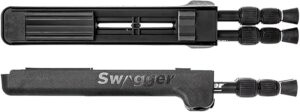
The Swagger Hunter Series Bipod is made with hunters and precision shooters in mind. It seamlessly transitions between prone, seated, and standing positions, ensuring that you’re always prepared to take the perfect shot, regardless of the terrain or situation.
One of the defining traits of the bipod is its versatility in shooting positions. Regardless of whether you’re prone for maximum stability, seated for a comfortable wait, or standing for a quick reaction shot, this bipod ensures you maintain a steady and reliable shooting platform. This flexibility is ideal for dynamic hunting environments and long-range scenarios where adaptability is key.
The bipod’s Quick Adapt Technology is a game-changer, allowing rapid adjustments to suit your needs on the fly. This ensures smooth transitions without fumbling, so you can stay focused through your scope and react to your target with precision. The result is an enhanced shooting experience, whether you’re tracking game in the wild or zeroing in at the range.
Built from impact-resistant composite materials, it is both lightweight and durable. It’s designed to withstand harsh conditions, including extreme cold and rugged terrains, without sacrificing comfort or usability. The absence of metal hinges ensures it won’t dig into your shoulder during transport, making it a pleasure to carry even on extended hunts.
Compatibility is another strong suit, with the included Standard Rifle Adapter, making the Swagger Hunter Series an excellent addition to a wide range of firearms. This ensures it integrates seamlessly into your hunting setup, providing a reliable foundation for your shooting needs.
Pros
- Highly versatile design allows transitions between prone, seated, and standing positions.
- Quick Adapt Technology ensures rapid, on-the-fly adjustments.
- Durable composite construction resists impacts and extreme cold.
- Metal-free design enhances carrying comfort during long hunts.
- Standard Rifle Adapter included for broad firearm compatibility.
- Lightweight and portable, making it easy to carry in the field.
Cons
- Quick Adapt Technology may require practice to fully master in high-pressure situations.
3) ACCU-TAC Fc-5 G2 Bipod
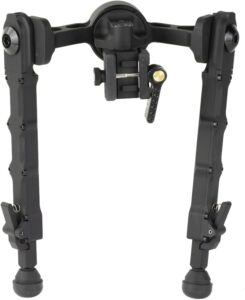
The ACCU-TAC Fc-5 G2 is another bipod that qualifies on our list. It is crafted from 6061 T6 aircraft-grade aluminum, which combines lightweight durability with a robust design. This all-billet construction, finished with Type III MIL-SPEC hard anodization, ensures that the bipod can endure the rigors of heavy use while maintaining its sleek, flat black appearance.
At 30.4 ounces, it offers a balance of portability and solid support, with a height range of 6 to 10.6 inches to suit various shooting setups.
One of the major highlights of the FC-5 G2 is its pan and cant adjustability, which allows shooters to fine-tune their aim to match uneven terrain or shifting targets. Both motions can be locked independently using an adjustable lever, ensuring maximum stability once set.
The quick-detach rail mount, compatible with standard 1913 Picatinny rails, allows for fast and secure attachment without the need for additional tools, saving time in dynamic shooting scenarios.
This bipod also boasts 4 independent leg positions and 9 notched height settings, offering exceptional versatility which make it a candidate for best bipod for long range. The spring-loaded legs are easy to adjust, with positions that lock securely at 45 or 90 degrees. The wide stance and lowered center ensure the rifle sits securely between the legs, reducing movement from recoil and supporting consistent accuracy.
Pros
- Exceptional build quality with durable 6061 T6 aluminum alloy construction.
- Pan and cant functionality, both lockable for precise adjustments.
- Quick-detach Picatinny rail mount ensures fast and secure attachment.
- Versatile leg positioning with 4 positions and 9 height options.
- Wide, stable base minimizes recoil-induced movement.
- MIL-SPEC hard anodized finish for durability and corrosion resistance.
- Independently adjustable legs for shooting on uneven terrain.
Cons
- Limited to Picatinny rail attachments, requiring adapters for other mounting systems.
4) Leapers UTG Tactical OP Bipod
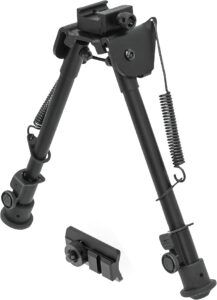
If you are a long-range shooter looking for versatility, durability, and precision, the Leapers UTG Bipod is what you need. It is engineered with durable aluminum construction and a steel top platform for exceptional strength while remaining lightweight at just 13.3 ounces.
The bipod features dual mounting options, including Picatinny and swivel stud mounts, making it compatible with a wide variety of rifles. This adaptability means it can attach securely to the bottom rail of most firearms, catering to different setups without requiring additional tools or modifications.
It features extendable legs with a quick-retraction button and a Posi-Lock wheel to ensure the legs stay firmly in place. The foldable arms with spring tension control allow for compact storage and easy deployment, while the rubberized feet enhance stability on uneven surfaces.
Moreover, the bipod’s panning capability makes it an excellent choice for tracking moving targets or adjusting to different angles, further boosting its versatility.
Pros
- Dual mounting system supports Picatinny and swivel stud rails for compatibility with most rifles.
- Durable aluminum and steel construction ensures longevity and reliability.
- Foldable arms with spring tension control for compactness and easy setup.
- Extendable legs with Posi-Lock for secure height adjustments.
- Panning capability allows smooth target tracking and angle adjustments.
- Lightweight design at 13.3 ounces for easy carry and handling.
- Rubberized feet for enhanced grip and stability on various surfaces.
Cons
- Panning mechanism might require frequent tightening for consistent performance.
5) GG&G XDS2-C Compact Tactical Bipod
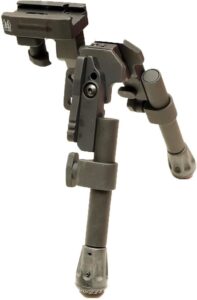
The GG&G XDS-2 is built from aircraft-grade 6061-T6 aluminum alloy with extreme-duty steel connection points and fasteners, giving it exceptional durability while maintaining a lightweight profile of just 15.4 ounces. Its Type III hard-anodized matte black finish ensures corrosion resistance and a non-reflective surface, ideal for tactical and outdoor applications.
This bipod is engineered for tool-free installation, attaching directly to any MIL-STD-1913 Picatinny or Weaver rail without requiring adapters. The quick-detach head allows for rapid mounting and removal, enabling seamless transitions between setups.
With 25° canting and 20° panning capability, shooters can adjust for uneven terrain or follow moving targets effortlessly. All adjustments are controlled by easy-to-use elliptical thumbnuts, allowing precise tension control.
Another feature that makes it one of the best bipod for long range recommendations is its silent spring-lock leg deployment, ensuring quiet operation during critical moments. The legs can be locked in multiple positions: folded forward, angled at 45°, or straight down.
When deployed, the height can be adjusted from 6 inches to 10.25 inches, offering flexibility for various shooting scenarios. Additionally, the legs can double as a vertical grip, enhancing versatility in dynamic shooting situations.
For stability, the XDS-2 is equipped with rubber all-weather feet, providing a secure grip on almost any surface. These feet are also replaceable, extending the product’s lifespan.
Pros
- Rugged construction using military-grade aluminum and steel for durability and reliability.
- Quick-detach system for rapid mounting and removal without tools.
- Adjustable leg positions (forward, 45°, and straight) for terrain adaptability.
- Height adjustability from 6 to 10.25 inches for versatility in shooting positions.
- Canting (25°) and panning (20°) capabilities for precise alignment and target tracking.
- Silent leg deployment minimizes noise during operation.
- Lightweight at 15.4 ounces, making it easy to carry in the field.
- Replaceable all-weather rubber feet ensure stability across surfaces.
- Durable Type III hard-anodized finish for corrosion resistance and tactical use.
Cons
- Higher price point compared to standard bipods.
- May require practice to fully utilize canting and panning features efficiently.
6) Harris Engineering S Series BRM M-LOK Bipod
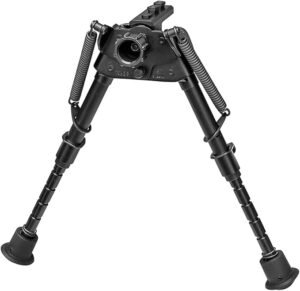
The Harris Engineering S Series BRM M-LOK Bipod is designed with thoughtful features and constructed to handle challenging terrain.
It extends from 6 to 9 inches, making it versatile for various shooting positions, especially when shooting prone. Its direct M-LOK attachment ensures a rock-solid connection to compatible handguards without requiring adapters, streamlining your setup.
The S Series BRM is engineered with swivel (tilt) compensates for uneven terrain, allowing you to maintain alignment and accuracy in unpredictable environments. The notched legs are spring-loaded for rapid deployment, letting you set up quickly in high-pressure situations.
Besides that, the three-piece smooth leg construction ensures durability and smooth operation, making adjustments seamless and precise.
Weighing just 18.6 ounces, the bipod is lightweight, reducing overall rifle weight while maintaining a robust, stable shooting platform. It also features a built-in sling swivel stud, enabling you to attach a sling for easy rifle transport.
That’s not all. It excels in uneven conditions like snow or tall grass, thanks to its elevated height range and solid construction.
Pros
- Lightweight design at 18.6 ounces, ideal for long treks or extended shooting sessions.
- Height adjustability for versatile shooting positions.
- M-LOK direct attachment offers secure, wobble-free mounting.
- Swivel (tilt) functionality compensates for uneven terrain.
- Spring-loaded notched legs for rapid and reliable deployment.
- Durable three-piece leg construction ensures longevity.
- Built-in sling swivel stud for added convenience.
- Compact and portable, perfect for field use.
Cons
- Limited to M-LOK handguards, reducing compatibility with other systems.
Factors to Consider When Choosing the Best Bipod for Long Range
Construction Materials
The first thing to consider when buying the best bipod for long range is the construction materials. Steel and aluminum are the most common materials. Steel is tough and robust, but heavier than aluminum. However, aluminum is a softer metal, making it more prone to unwanted dents and bends. For this reason, many products incorporate a combination of both materials to offer the best of both worlds.
Weight and Portability
Long-range shooting often involves moving to different shooting spots, so the weight and portability of the bipod matter. A lightweight bipod is easier to carry, especially during extended sessions or in rugged terrain. However, ensure that the reduced weight doesn’t compromise stability. Strike a balance between portability and robust construction to avoid affecting your shooting accuracy.
Height Range and Adjustability
The height range and adjustability of the bipod are essential for ensuring proper shooting position. Long-range shooting often requires precise alignment with the terrain, and a bipod with adjustable legs allows you to stabilize your rifle on uneven surfaces. Consider a bipod with a wide height range to accommodate various shooting scenarios and positions, from prone to seated. Additionally, features like independent leg adjustment and locking mechanisms enhance versatility and reliability.
Attachment System
The compatibility and ease of the bipod’s attachment system should match your firearm setup. Most bipods attach via a Picatinny rail, M-LOK, KeyMod, or a sling swivel stud. Ensure that the bipod is compatible with your rifle’s mounting system and consider quick-detach options for rapid setup and removal. A secure and stable attachment is vital for maintaining accuracy in long-range shooting.
Stability
Stability is king when it comes to long-range accuracy. The best bipod for long range should have features like a wide stance, non-slip feet, and a solid locking system to minimize movement during shooting. Additionally, pivoting and canting capabilities are beneficial for adapting to uneven terrain. These features allow the shooter to adjust the angle of the rifle without repositioning the entire setup, which is particularly useful when targeting at varying distances or angles.
Cost and Brand Reputation
The cost of the bipod should reflect its features and build quality. While budget options may suffice for casual use, investing in a high-quality bipod from a reputable brand can significantly enhance your long-range shooting experience. Trusted manufacturers often provide warranties and better customer support, ensuring long-term reliability. Research reviews and recommendations to find a bipod that offers the best value within your budget while meeting your performance needs.
FAQs
- How Long Should a Bipod Be?
The ideal length of a bipod depends on your shooting style and typical shooting position. For long-range precision shooting, a bipod with adjustable legs that extend from 6 to 9 inches is often suitable for prone positions, offering a stable and low-profile setup.
If you frequently shoot in seated or kneeling positions, consider a bipod with a taller range, such as 9 to 13 inches or more. Adjustable bipods provide versatility, allowing you to adapt to various terrains and shooting angles. Ultimately, the bipod’s length should match your needs while ensuring a comfortable and stable shooting experience.
- Should You Put a Bipod on a Hunting Rifle?
It depends on the kind of hunting you do. If you are hunting pronghorn or mule deer in open country, such as clear cuts or meadows, a bipod can be invaluable. It provides a stable platform for your rifle, ensuring steadiness and allowing for more precise and accurate shots in these expansive, open environments.
Conclusion
We hope that this review has been insightful and has helped you find the best bipod for long range. By investing in a durable, versatile, and reliable bipod, you’ll set a solid foundation for achieving precision in long-range shooting.

